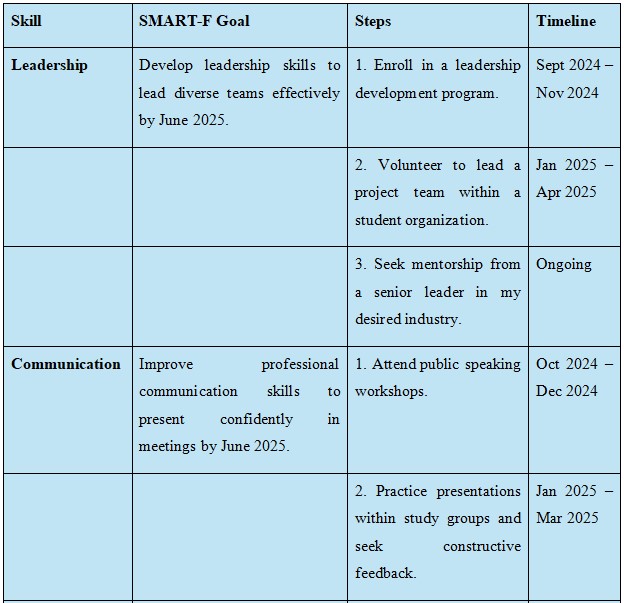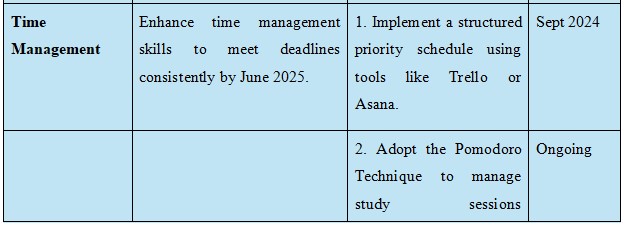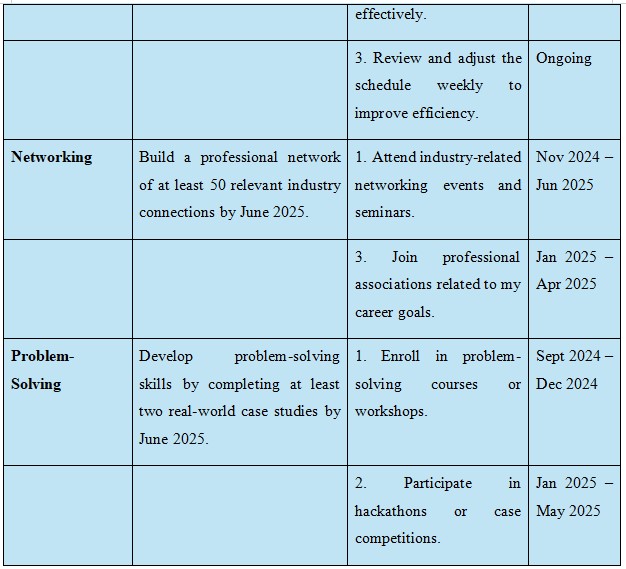Developing Professional Competencies and Personal Branding for Career Readiness EMP4021
- Subject Code :
EMP4021
Section 1: My Action Plan
1a. Action Plan



1b. Action Plan Reflection
Leadership:
These steps are important in developing leadership skills because leading a team requires more than theoretical knowledge; it requires practical experience and mentorship. Volunteering to lead a project team will provide hands-on experience, while the mentorship will provide the experience of someone who has gone through the pitfalls of leadership. These experiences will be important when trying to show leadership ability to prospective employers.
Communication:
Public speaking is an art that no professional can live without, and practice in itself calls for a feedback component to improve. Some of the things I have identified in my action plan include attending workshops and seeking feedback, which directly help me gain confidence and clarity within a professional setting. Practice within study groups allows a safe space for mistakes and lessons. One barrier might be public speaking anxiety.
Time Management:
Scheduling time appropriately has been a crucial ingredient in both academics and professional fields. Using a priority schedule together with the Pomodoro Technique will enable me to manage my time effectively. I can always go over it every week just to ensure that I am adhering to this schedule and change where necessary. I'll allow myself buffers for contingencies in case something unplanned happens, so if these cases happen, it wouldn't be much of a hassle.
Networking:
A successful career relies on the development of a good network. Events and connections on LinkedIn will establish a firm network to support my career path. Having engaged in professional associations also allows one to meet similar people. The challenge that I would face is when I feel apprehensive about new connections; this means my plan B is to start with people whom I already know, and then ask for introductions to others.
Problem-Solving:
The development of problem-solving skills with the help of case studies is important; it shows a person's thinking and problem-solving capability in difficult situations. Practical experience means a lot for employers, so hackathons and case competitions will be included.
Section 2: My Professional Brand Online Profile
Screenshots of my LinkedIn profile as described in the brief will be included here.
Section 3: My Professional Brand Network Contribution
Chosen prompt: Treating different things the same can generate as much inequality as treating the same things differently. Kimberl Crenshaw (Civil Rights Advocate and Professor at UCLA School of Law)
Headline: "Equality vs. Equity: Navigating the Fine Line in Professional Spaces"
Hook: Imagine being given the same tools to succeed, but your challenges are uniquely your own. Is this fairness or a subtle form of inequality?
Content: These days, with a rapidly changing workplace, the words equality and equity are often used interchangeably but not necessarily understood. Whereas equality approaches treat everyone the same, equity does just the opposite. It treats each person uniquely and in such a manner as to try to tailor support to that uniqueness. Kimberl Crenshaw brings clarity: "Treating different things the same can generate as much inequality as treating the same things differently".
Imagine a new graduate and a seasoned professional that are put on the same level in terms of responsibility given to them, resources availed to them. This appears as fair. However, the graduate may need guidance and mentorship to work at the same level as the experienced professional. In other words, such organizational treatment creates a barrier to the graduate's success and generally reinforces inequality. Real equality recognizes the different starting points and then advances appropriate supports as a means of ensuring they all succeed (Dworkin, 2017).
Organizations will better address this issue if they consider the following recommendations:
1.Understanding Individual Needs: The first critical point is an acknowledgement that each employee brings different strengths and weaknesses to the table. This can mean regular one-on-one meetings where specific needs are identified and appropriate support mechanisms are developed toward addressing those needs (Deutsch et al., 2017).
2.Inclusivity: This can be achieved by developing an open culture where people can share their issues without fear. Inclusion means identifying these differences and their value, then acting to provide for the business needs to enable all.
3.Implement Equity-Based Policies: Sometimes, it's a matter of moving away from the one-size-fits-all and going to something more individualistic in nature. It could be part of flexible work arrangements, specialized professional development opportunities, or even mentoring programs that are carved out for experience levels (Ibarra, 2023).
It is with equity, rather than strict equality, that an enabling environment can be fostered within organizations and ensure that all employees have an opportunity to realize their full potential (Mayer, Oosthuizen, and Tonelli, 2019). In such a way, each person benefits, and so does the team in terms of innovation and productivity.
Biography: I am passionate about creating inclusive and equitable workplaces. I strive to bridge the gap between theory and practice in diversity and inclusion. Lets connect and drive meaningful change together.
Image:

Figure 1 Diversity and equity in the workplace
Source:(Will, 2021)
Are you struggling to keep up with the demands of your academic journey? Don't worry, we've got your back!
Exam Question Bank is your trusted partner in achieving academic excellence for all kind of technical and non-technical subjects. Our comprehensive range of academic services is designed to cater to students at every level. Whether you're a high school student, a college undergraduate, or pursuing advanced studies, we have the expertise and resources to support you.
To connect with expert and ask your query click here Exam Question Bank

